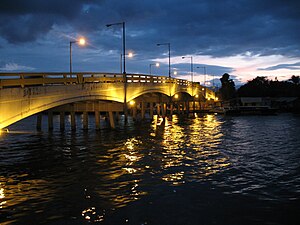Puerto Cortes
|
Puerto Cortés Puerto Caballos |
||
|---|---|---|
| town | ||

The bridge into Puerto Cortés
|
||
|
||
| Nickname(s): "El Puerto" | ||
| Coordinates: 15°51′N 87°56′W / 15.850°N 87.933°W | ||
| Country |
|
|
| Department | Cortés | |
| Founded | 1524 | |
| Area | ||
| • Total | 391 km2 (151 sq mi) | |
| Population (2015) | ||
| • Total | 126,009 | |
| • Density | 320/km2 (830/sq mi) | |
| Time zone | América Central (UTC-6) | |
Puerto Cortės, originally known as Puerto de Caballos, is a city on the north Caribbean coast of Honduras, right on the Laguna de Alvarado, north of San Pedro Sula and east of Omoa, with a natural bay. The present city was founded in the early colonial period. It grew rapidly in the twentieth century, thanks to the then railroad, and banana production. In terms of volume of traffic the seaport is the largest in Central America and the 36th largest in the world. As of 2014, Puerto Cortés has a population of some 200,000.
Gil González Dávila founded the city in 1524 and called Villa de la Natividad de Nuestra Señora, now known as Cieneguita. In 1526 Hernán Cortés came to punish González Dávila and when he arrived on Honduras' coast from Mexico and started unloading horses and cargo from the ships, several horses were drowned, and for that reason Cortés called it Puerto Caballos. By 1533, a local native leader, called Çiçumba (or Çoçumba, or Socremba, or Joamba ... we don't really know since the Spanish recorded so many variants of his name) had destroyed the town, reportedly taking a woman from Sevilla, Spain captive. After Çiçumba's defeat in 1536 by Pedro de Alvarado, a new town, Puerto de Caballos was founded on the southern shore of the body of water known as the Laguna de Alvarado.
The English attacked Puerto Caballos as they did other places along the Honduran coast.Christopher Newport briefly occupied the town in the Battle of Puerto Caballos, part of the Anglo–Spanish War. Because it was vulnerable to pirates until the building of the Spanish fort at Omoa in the 18th century, it had few permanent residents in the 16th and 17th centuries. People preferred to come out to the coast from San Pedro when a ship came into port. In 1869 Puerto Caballos changed its name to Puerto Cortés in honour of Hernán Cortés.
...
Wikipedia


